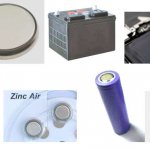High temperature is the worst enemy of batteries, including lead acid. It is said that adding temperature compensation to the lead-acid charger to adjust for temperature changes can extend battery life by 15%. For every degree of temperature increase, the recommended compensation is a 3mV drop per battery. If the floating voltage is set to 2.30V/battery at 25°C (77°F), the voltage should be read as 2.27V/battery at 35°C (95°F). It is colder, the voltage should be 2.33V/battery at 15°C (59°F). These 10°C adjustments represent 30mV changes.
Lead-acid batteries

The following table shows the best peak voltage at various temperatures when charging lead-acid batteries. The table also includes the recommended float voltage when in standby mode.
| Battery status | -40°C | -20°C | 0°C | 25°C | 40°C |
| Voltage limit when charging | 2.85V /cell | 2.70V /cell | 2.55V /cell | 2.45V /cell | 2.35V /cell |
| Float voltage at full charge | 2.55V /cell
or lower |
2.45V /cell
or lower |
2.35V /cell
or lower |
2.30V /cell
or lower |
2.25V /cell
or lower |
Table 1: Recommended voltage limits for charging and maintaining fixed lead-acid batteries during floating charge. When working under extreme temperatures, voltage compensation can extend battery life.
Nickel-based batteries
Charging nickel-based batteries (like NiMH battery) at high temperatures reduces oxygen production, which reduces charge acceptance. The heat makes the charger mistakenly believe that the battery is not fully charged.

When warm, charging nickel-based batteries reduces oxygen production, thereby reducing charge acceptance. The heat makes the charger mistakenly believe that the battery is not fully charged. Above 30°C (86°F), the charging efficiency drops significantly. At 45°C (113°F), the battery can only accept 70% of its full capacity; at 60°C (140°F), the charge acceptance rate drops to 45%. The NDV used for full charge detection becomes unreliable at higher temperatures, and temperature sensing is essential for backup.
Lithium ion batteries
Lithium ions(including lipo batteries) perform well at high temperatures, but prolonged exposure to heat sources can extend their service life. Charging and discharging at elevated temperatures generates gas, which may cause the cylindrical battery to vent and the pouch battery to swell. Many chargers prohibit charging above 50°C (122°F).

Some lithium-based packages are temporarily heated to high temperatures. This applies to batteries in surgical tools, which are sterilized at 137°C (280°F) for up to 20 minutes during autoclaving. As part of the fracturing technique, oil and gas drilling also exposes the battery to high temperatures.
The capacity loss at high temperatures is directly related to the state of charge (SoC). Li-cobalt (LiCoO2) cycling at room temperature (RT) generally does not have a significant capacity loss. At 130°C and 20% SoC, 10 cycles can produce a slight capacity loss. The loss is higher at 130°C and 50% SoC, and shows a devastating effect when fully charged.

